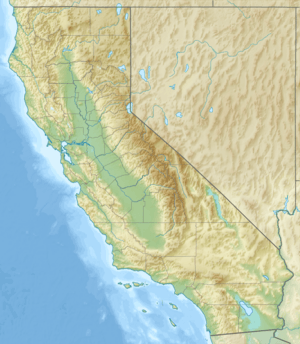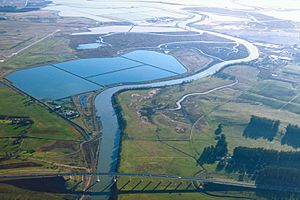Napa River facts for kids
Quick facts for kids Napa River |
|
|---|---|

|
|
|
Location of the mouth of the Napa River in California
|
|
| Country | United States |
| State | California |
| Region | Napa County, Solano County |
| City | Napa |
| Physical characteristics | |
| Main source | Mount Saint Helena Mayacamas Mountains 3,745 ft (1,141 m) 38°39′52″N 122°37′14″W / 38.66444°N 122.62056°W |
| River mouth | Carquinez Strait San Pablo Bay 0 ft (0 m) 38°4′12″N 122°14′38″W / 38.07000°N 122.24389°W |
| Length | 55 mi (89 km) |
| Basin features | |
| Basin size | 426 sq mi (1,100 km2) |
| Tributaries |
|
The Napa River is a 55 miles (89 km) long river in California, a state in the United States. It flows through the famous Napa Valley, a region known for growing grapes for wine. The river starts in the mountains north of the San Francisco Bay. Many smaller streams, like Milliken Creek, flow into the Napa River. The river ends near Vallejo, where its fresh water mixes with the salty water of the Carquinez Strait and San Pablo Bay.
Contents
Where Does the Napa River Flow?
The Napa River begins in the northwestern part of Napa County. It starts just south of Mt. St. Helena in the Mayacamas Mountains. The very beginning is a seasonal stream called Kimball Canyon Creek. It flows from an elevation of 3,745 feet (1,141 m).
The river then flows south for about 4 miles (6 km). It enters the narrow Napa Valley north of Calistoga. As it continues, it flows southeast past towns like Calistoga, St Helena, Rutherford, and Oakville. It also flows through the city of Napa.
After Napa, the river becomes a tidal estuary. This means it's a place where fresh water from the river mixes with salty ocean water. It then flows into the Mare Island Strait. Finally, it empties into San Pablo Bay through the Napa Sonoma Marsh.
The Napa River's Watershed
A watershed is an area of land where all the water drains into a single river or body of water. The Napa River watershed covers about 426 square miles (1,103 km²). Many smaller streams, called tributaries, feed into the Napa River. Some of the larger ones include Dry, Conn, and Soda creeks.
Over the years, the main Napa River has cut deeper into the land. This means some smaller streams now sit higher than where they meet the river. This can make it hard for fish to swim upstream to their spawning grounds.
Several large dams were built on major tributaries between 1924 and 1959. These include dams on Conn, Rector, Milliken, and Bell creeks. Kimball Dam is also in the northern part of the river's headwaters. These dams block fish like salmon and steelhead from reaching their old spawning areas. Many smaller dams are also found throughout the watershed.
Amazing Animals of the Napa River
The Napa River is home to many different kinds of fish. It also has recovering populations of salmon and steelhead trout. These include chinook salmon (Oncorhynchus tshawytscha) and steelhead trout (Oncorhynchus mykiss).
Since 2003, a group called the Napa County Resource Conservation District has been watching the salmon. They have seen about 400 to 1000 fall-run Chinook salmon return to the river each year. These salmon usually arrive between late October and January.
Scientists have found that some Chinook salmon in the Napa River came from the Klamath River. This shows that salmon can travel long distances to find new places to live and reproduce.
Historically, the Napa River basin likely supported many steelhead and coho salmon (Oncorhynchus kisutch). However, by the late 1960s, coho salmon disappeared from the river. The steelhead population has also greatly decreased. Less water in some streams makes it harder for young steelhead to find food and survive.
Recently, a chum salmon (Oncorhynchus keta) and a sockeye salmon (Oncorhynchus nerka) were also found in the river. This means the Napa River supports four different types of salmon!
The Napa River basin has more types of native fish than even the larger Sacramento and San Joaquin River systems. It has sixteen native fish species. These include:
- Steelhead
- Fall-run Chinook salmon
- Pacific lamprey (Lampetra tridentata)
- River lamprey (Lampetra ayresi)
- Hardhead (Mylopharodon conocephalus)
- Hitch (Lavinia exilicauda)
- Tule perch (Hysterocarpus traski)
- Sacramento splittail (Pogonichthys macrolepidotus)
Because of this amazing variety of fish, the Napa River is considered very important to protect. Other fish like white sturgeon (Acipenser transmontanus) also use the Napa River watershed.
The California golden beaver (Castor canadensis subauraticus) used to live here a long time ago. Recently, beavers have returned to the Napa River. They have been seen in Napa, Rutherford, and Oak Knoll. Beavers are important because their dams help increase the number and types of fish, birds, and mammals. They also help keep the water clean for trout and salmon.
Efforts to Restore the Napa River
In the 1970s, a concrete cover was removed from parts of Napa Creek. This allowed the water to be seen again, which is sometimes called "daylighting." However, this project didn't focus much on the river's natural environment.
More recently, vineyard owners along the Rutherford Reach are helping the river. This is a 4.5-mile (7.2 km) section of the Napa River between St. Helena and Oakville. These owners are letting some of their valuable land return to its natural state. This project, called the Rutherford Restoration Project, involves 23 property owners. They have set aside 18 acres (73,000 m2) of land to help the river's ecology.
After this restoration, native North American beaver returned to the area. They have built 3-4 beaver dams. These beavers are known as keystone species. This means they are very important to their ecosystem. They help improve water quality and create better homes for fish, birds, and other animals.
The southern part of the river is also being restored. Old salt ponds along the river are being changed back to their natural marsh state.
The Great Napa Flood of 1986
The Napa River has flooded many times. Since 1865, there have been 23 recorded floods. The worst one happened in 1986. During this flood:
- 5,000 people had to leave their homes.
- 250 homes were destroyed.
- Three people sadly lost their lives.
After this terrible flood, a plan called the Napa River Flood Project was restarted. The project was redesigned and approved by local voters in 1998. Construction began in 2000 and was finished by 2015. This project aimed to help prevent future floods.
Fun Things to Do on the Napa River
The Napa River and the land around it offer many ways to have fun!
- Kayaking and Rafting: You can go Whitewater kayaking and rafting on the upper part of the river, from St. Helena to Napa.
- Boating: The lower part of the river, from Napa to San Pablo Bay, has calm water. It's great for canoeing, sea kayaking, and motorboating.
- Hiking and Biking: The Napa River Trail has sections for walking and biking. You can find parts of the trail at Kennedy Park and between Lincoln Avenue and Trancas Street in the city of Napa.






